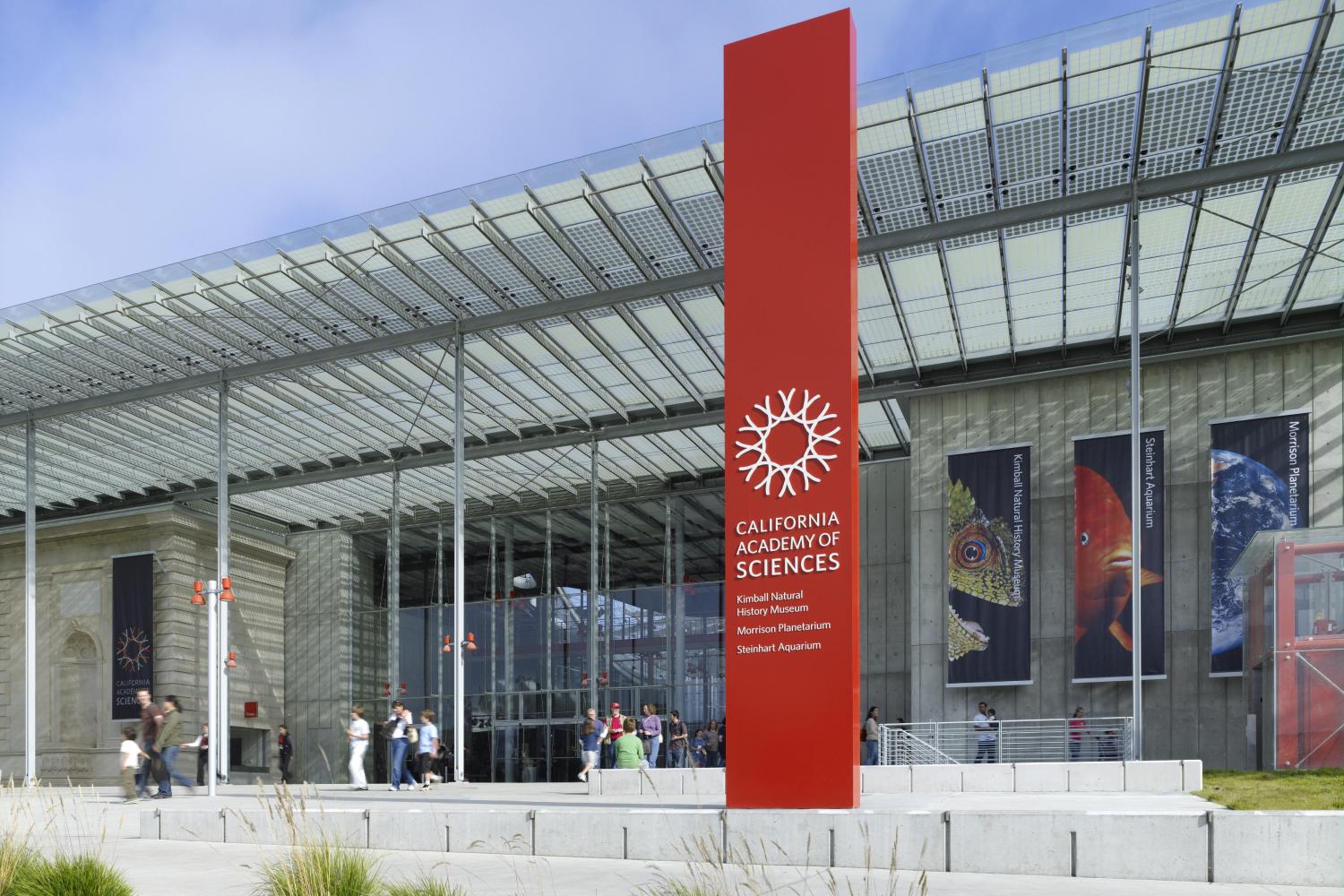Yesterday, I got to drive a car full of kids to the California Academy of Sciences in San Francisco. The drive each way was three hours; remarkably, that’s using the car pool lane otherwise it would have taken much longer.
For the trip, I figured that I would use Google Maps instead of my car’s navigation system since cities like San Francisco and Sacramento like to arbitrarily change the direction of one-way streets and add random bike lanes where cars once freely roamed. I figured, if there was an area that Google had down cold, it would be the highways and byways of their own backyard. Sadly, my experience was less than satisfactory. Things were OK until I got in San Francisco and then, when I needed it, Google failed. Twice when going down the highway (I-80 and then Highway 101), Google suddenly put me on surface streets just because I did a lane change. Worst of all, when exiting 101, it was totally messed up and kept rerouting me to get me lined-up to head west on surface streets towards Golden Gate Park.
Finally, we turned from John F Kennedy Drive to Nancy Pelosi Drive and got our first look at our destination.
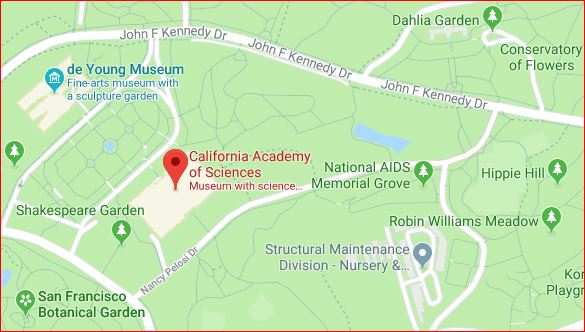
Folks, in principle, I hate anything named after individuals that are still alive. Lots of people start well and finish life poorly. I’m speaking in generalities and being very charitable in this instance. I think the filter of history needs to weigh a person’s life before naming public places (or holidays) after them. This is not a slam on just Pelosi but my town of Elk Grove as well. Elk Grove is constantly naming parks and schools after living people. My reaction on hearing the name of the street (Nancy Pelosi) was mirrored by one of my son’s friend that verbalized my feelings. Folks, knowing that the boundaries of the museum are in part defined by invoking Nancy Pelosi’s name, is what is known in literature as foreshadowing.
The California Academy of Sciences is a composite of different areas under one roof. For one price you get access to an aquarium, planetarium, rainforest, and natural history museum. I have seen better displays elsewhere but for northern California, it is a respectable assembly of experiences in one place.
Steinhart Aquarium
The Steinhart Aquarium—which used to be a standalone attraction—is the best part of the museum. It is a fraction of the size of the Monterey Bay Aquarium but does boast an impressive display of mature freshwater fishes including some trophy sized arapaima.
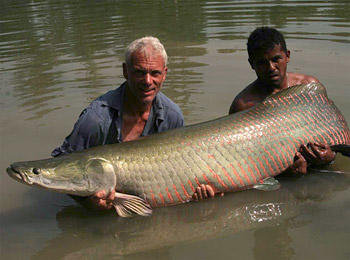
The largest saltwater tank is supposed to be representative of a reef system in the Philippines; however, I doubt its authenticity. As it happens, I have scuba dived in the Philippines and many fish that I frequently saw while diving were missing from the display.
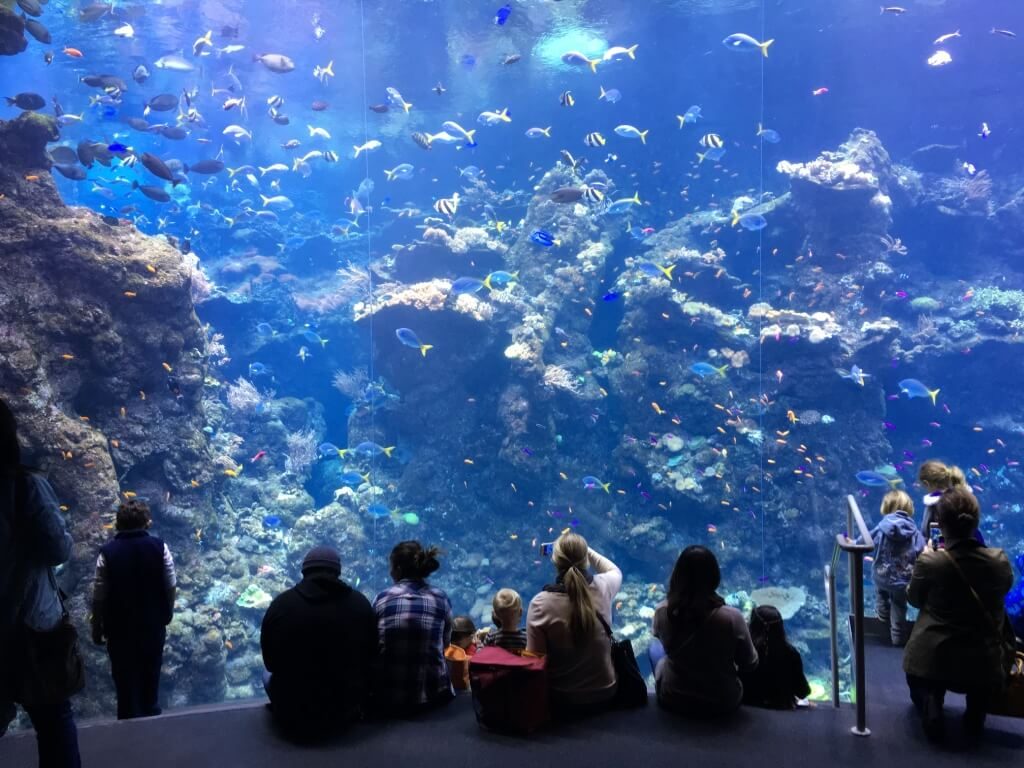
Also strangely absent from the displays were sharks. In many of the smaller salt water tanks, I saw algae and other things indicative of poor water quality. I think there is room for improvement in this area. This is one area that Monterey Bay beats all others since they take water directly out of the sea and don’t have to recycle and extensively tinker with water chemistry.
Osher Rainforest
The Osher Rainforest is supposed to represent a generic rainforest. It is housed in a Plexiglas bubble structure with a pathway through it. You walk up several levels from the ground to the tops of the trees. The most predominant feature is the assortment of butterflies. Also, you will notice various tropical birds. The exhibit is kept humid compared to the outside air but it’s not really as humid as a tropical region (otherwise my glasses would have instantly fogged over). Various small insects are displayed as you go thru the display including beetles, ants, etc. Signs also make mention of the roles of elephants and apes in such an environment. Of course there are also signs claiming that the Amazon rainforest is in danger due to human activity like logging and agriculture.
Morrison Planetarium
The Morrison Planetarium can seat several hundred people. Sadly, we didn’t see a show about the stars but instead a film about oceans. The film was Expedition Reef. This film is completely computer generated. It begins at the Philippine reef display at the aquarium and then does a reverse angle to reveal the open sea in all its CGI glory. The production is stunning except for one small problem, the sea doesn’t look anything like it does in the film. Folks 4K photography can’t really capture the brilliance of the undersea adventure let alone the limitations of CGI. The colors and lighting of this film was more akin to diving just after sunset than in broad daylight. The scope of seeing it on the planetarium screen was reminiscent of an IMAX presentation.
Below is a summary of the film’s content.
Narrated by Tony Award® winner Lea Salonga, the all-digital Expedition Reef takes full advantage of the Morrison Planetarium’s fulldome screen to immerse you in the undersea adventure. Along the way, discover how corals grow, feed, reproduce, and support over 25% of all marine life on Earth—while facing unprecedented threats from climate change, habitat destruction, and overfishing.
Expedition Reef
“This is a difficult story [and] a turning point for reefs,” says Academy scientist and reef expert Dr. Rebecca Albright, “but it’s not too late.”
Folks, while much of the usual Darwin and millions of years was missing from many of the displays, radical environmentalism was front and center of this whole place. The centerpiece of this worldview was this film at the museum. In it we are told that we need to stop using plastic, synthetic materials for clothing, and reduce CO2 emissions amongst other things. As always, we are told that by some arbitrary date in the future, in this case 2050, it will be too late.
The plastic waste in the seas was presented as being all our fault because of our lifestyle even though most of the trash in the world’s oceans is from Asian countries.
In 2015, a study published in the journal Science sought to discover where exactly all of this garbage is coming from. According to the researchers, the discarded plastics and other debris floats eastward out of countries in Asia from six primary sources: China, Indonesia, the Philippines, Vietnam, Sri Lanka and Thailand. In fact, the Ocean Conservancy reported that China, Indonesia, Philippines, Thailand, and Vietnam dump more plastic in the sea than all other countries combined. China alone is responsible for 30% of worldwide plastic ocean pollution.
Great Pacific garbage patch
Also, this film neglects that the plastic in the ocean is serving as impromptu coral reefs with millions of creatures including juvenile fish living in their midst. In fact these trash zones have their own unique ecosystems.
Imagine you’re on a small boat in the middle of the open ocean, surrounded by what looks like a raft of plastic. Now flip the whole world upside down. You remain comfortably attached to your seat—the abyss towers above you, and all around, stretching up from the water’s surface, is an electric-blue meadow of life. What you thought was plastic is actually a living island. This meadow is made up of a diverse collection of animals. The most abundant are blue buttons and by-the-wind sailors, with bright-blue bodies that dot the sky like suns, and deep-purple snails found in patches so dense one scientist described collecting more than 1,000 in 20 minutes.
This is the neuston, a whole ecosystem living at the ocean’s surface. I once stumbled upon a raft of neuston when a storm blew it ashore in California. Many neustonic animals are vibrant highlighter colors, and the sand was saturated in bright blues and pale pinks. Together, these small creatures may function like upside-down coral reefs: an oasis of shelter and life far out to sea. As far back as the Cold War era, scientists were describing these colorful and important ecosystems, yet they still remain all but unknown. But now, as efforts to clean the ocean of plastic start up, our ignorance is putting this ecosystem at risk.
The neuston is home to more than blue buttons and bright snails. Erupting through the lawn of blue are crackling purple, red, gold, and yellow strands. These are Portuguese man o’ wars, whose tentacles stretch like lightning from the meadows of blue and pink. And among them, dragons roam.
Small nudibranchs, known as blue sea dragons, feast on blue buttons and man o’ wars, using their winglike cerata to grab and hold onto their tentacled prey. There are sea anemones, barnacles, copepods, color-changing crabs, specialized bacteria, even bugs, all living in this inverted reef in the middle of the open ocean. (Organisms that live exclusively by floating at the surface of the water are called pleuston, while neuston is a broader term, referring generally to the sea-surface ecosystem, which is why I chose to use it here.)
Just like reefs on the seafloor, this ecosystem does not stand apart from the open ocean around it. The neuston is a nursery for multiple species of larval fish and a hunting ground for paper nautilus octopuses. It supports sunfish, leatherback turtles, and diverse ocean grazers, which frequent these islands, relying on them as a food source. At night, soft-bodied jellies rise up to join the neuston, sparkling like fireflies. But all of this, from the blue sea dragons to the by-the-wind sailors, is in peril.
When I learned about the Ocean Cleanup project’s 600-meter-long barrier with a three-meter-deep net, a wall being placed in the open ocean, ostensibly to collect plastic passively as the currents push water through the net, I thought immediately of the neuston. How will it be impacted? But in the 146 pages of the Ocean Cleanup’s environmental-impact assessment, this ecosystem isn’t mentioned once.How Plastic Cleanup Threatens the Ocean’s Living Islands
I was disturbed by this omission. Though the neuston isn’t known to many people, it is certainly known to marine biologists. Evidence that the Ocean Cleanup knows about the neuston is clear from a table reporting animals in the vicinity of the Ocean Cleanup deployment area, where both blue buttons and by-the-wind sailors are listed. But the ecosystem itself is never discussed. By omitting the neuston from its assessment, the project is overlooking the habitat it could be impacting most, and there is no sense of what the damage might be.
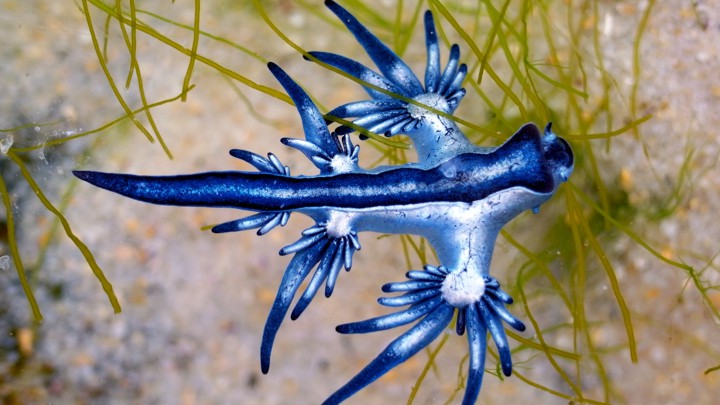
We were told in the film not to wash our clothes because doing so introduces microscopic plastic fibers into the water. We are also told in the film that plastic can never truly be removed from the environment once introduced into the water which is false.
Did you know that microscopic critters are actually eating and dissolving the plastic?
Many flourishing microbes appear to interact with the plastic surfaces we examined. These observations, together with findings from previous studies, suggest that microbes are helping to break down plastics at sea. This could be another explanation for the less-than-expected level of plastic pollution at surface waters.
Creatures living on tiny ocean plastic may be cleaning our seas
Plastic-eating microbes may also support biotechnological solutions for better plastic waste disposal practices on land. Perhaps in the future, we may come up with industrial “composts” that can break down our plastic waste.
Living Roof
This radical environmental theme is found throughout the museum but the film, Expedition Reef, is the centerpiece of the message. Second only to the film is the “Living Roof.” I found this quite hypocritical given the construction materials used in the building. The Living Roof is described as:
Our living roof is more than beautiful—it’s the heart of the Academy. Weather stations on the roof monitor wind, rain, and changes in temperature to help inform the building’s automated systems and skylights, keeping rainforest temps just right, the interior piazza cool and comfortable, and natural light streaming to the exhibits below.
Living Roof
Edged by solar panels, the roof’s seven hills are lined with 50,000 porous, biodegradable vegetation trays made from tree sap and coconut husks. An estimated 1.7 million plants fill the trays, their roots interlocking to create an extraordinary oasis for birds, insects, people, and other creatures.
The Power of Green
The Living Roof provides excellent insulation (reducing energy needs for heating and cooling), captures 100% of excess storm water (preventing runoff from carrying pollutants into the ecosystem), and transforms carbon dioxide into oxygen—just for starters.
Sounds really green right? Only problem is that the living roof is only possible because it is coated with polystyrene and other petroleum based materials which allow the roof to be inches thick on top of a concrete roof. Only because of the plastics used can the roof absorb rain water, retain moisture, not leak, and give enough anchor points for the roots so plants can grow.
As with any other modern structures, the building is built of Plexiglas, steel, and concrete. Yes it’s certified as a “green” building but only because of these materials and a host of petroleum based products used in things like solar cells, wiring, plastic piping, and various displays.
Given their radical environmental posture, it makes me wonder why plastic is ok for them and not us. Lest you think I was alone in perceiving a double standard, the students in my car noted the plastic waste in the museum’s food areas as contrary to their message.
Natural History Museum
Scattered in various places were displays collectively known as the Natural History Museum. At the entrance to the building is a plastic or fiberglass reproduction of a T-Rex skeleton along with the obligatory plaque touting the millions of years old party line.
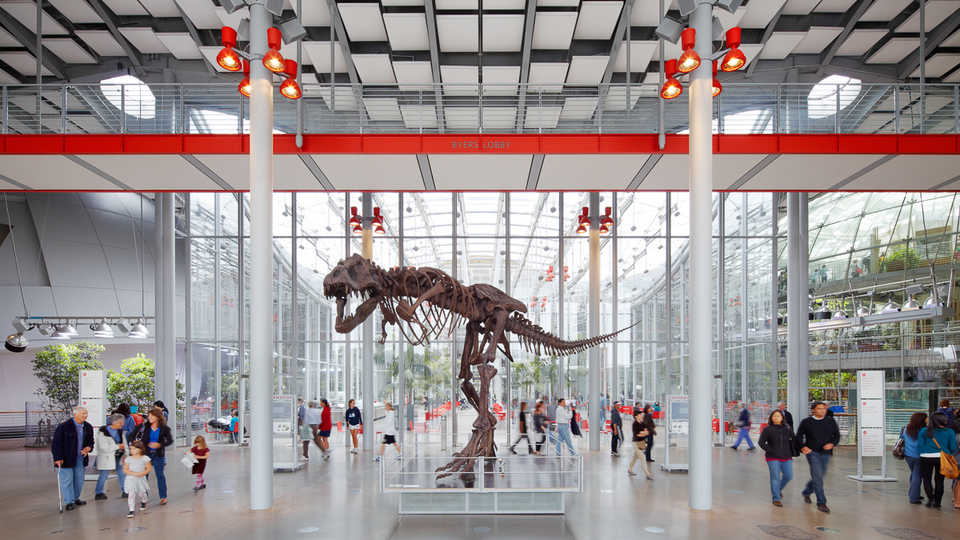
A section dedicated to the continent of Africa also has a brief mention of human evolution on one wall and various displays of taxidermied animals. No other continent had its own display area. Also, there is a section dedicated to mammals that live in the Pacific Ocean. Whales and sea otters made up much of this portion. A docent was allowing people to see pieces of whale baleen.
FYI The docents that I spoke to were all nice and willing to talk about their subject areas with visitors.
Conclusion
The radical environmental message needs to be countered by parental discussion. I’ve provided you with at least a few resources in the discussion above to counter some claims made environmentalists. None of us is in favor of trashing the planet but saying it’s all my fault because I happen to live in the United States is disingenuous. As stated elsewhere on this blog, our recycling scheme is broken and needs a private sector solution.
This Gaia worship is wrapped in scientific sounding jargon but don’t surrender to this false religion. God has put man in charge of the planet while the view portrayed at the California Academy of Sciences is that man is the cancer that plagues the planet. A proper Christian worldview would go a long way towards fixing our understanding of this issue. Over time, I think that will happen but not by following the environmentalist religion but by the Gospel permeating the world and bringing into subjugation every area of life to the authority of God’s Word.
If you make the trip to Golden Gate Park during the week, allow plenty of time to drive and expect to spend much on bridge tolls, parking, and food. Not counting the admission tickets, I think I spent about $120 for my son and I to participate in this outing. Truthfully, if you can; go to Monterey Bay Aquarium instead. The food on Cannery Row is world class and the aquarium is better.
Lastly, remember my pet peeve about naming things after people that are still alive, when did the Bay Bridge get renamed the Willie L Brown Jr. Bridge?
